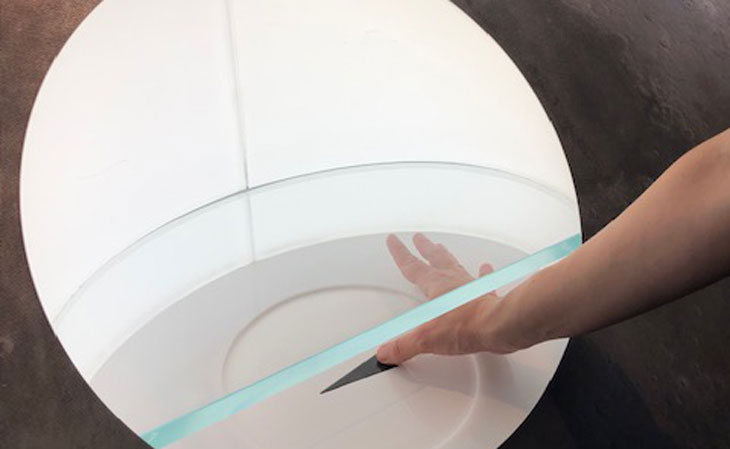Welcome to moon rock central
These Apollo samples are more precious than gold
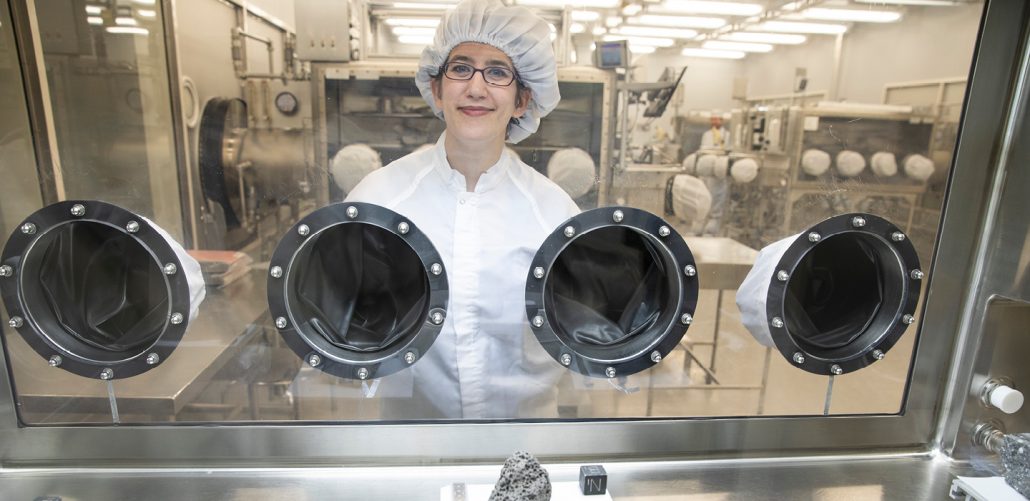
Science News astronomy reporter Lisa Grossman visits the pristine-sample lab at NASA’s Johnson Space Center in Houston. The display case holds rocks collected by the Apollo 15 and 16 missions. The 1.5-kilogram (3.3-pound) chunk of volcanic basalt in the center is 3.4 billion years old.
Felix Sanchez
Science News for Students is celebrating the 50th anniversary of the moon landing, which passed in July, with a three-part series about Earth’s moon. In part one, Science News reporter Lisa Grossman visits rocks brought back from the moon. Look for part two in October and part three in November. And check out our archives for this story about Neil Armstrong and his pioneering 1969 moonwalk.
HOUSTON, TEXAS — Through glass windows, I can see rocks and trays of dirt that Apollo astronauts brought to Earth decades ago. But my tour guides here at NASA’s Johnson Space Center are firm: Nobody touches the moon rocks!
I’ve spent years looking at cosmic rocks from a distance. My childhood involved lots of stargazing through a telescope. My lab job in college involved processing pictures of Mars. So this trip is a big deal for me. I’ve been itching to scoop up a handful of alien sand and let it run through my fingers. Today, the opportunity feels as close as it is unlikely.
Before entering this clean room, I remove all of my jewelry, including my wedding ring. My guides and I cover our shoes with blue paper booties and step into full-body jumpsuits. Their zippers go from navel to neck. Snaps close openings at the ankles, wrists and throat. Once in these white bunny suits, we put on neoprene gloves and a hair cover. Then we pull up a pair of knee-high boots over the blue booties. Finally, we spend a full minute standing in a phone booth–sized air shower. A steady breeze there blows from ceiling to floor, clearing us of any lingering dust.
Inside the clean room, I face another barrier: The rocks are stored in secure, pressurized cabinets. They look like big terrariums, in this case filled with pure nitrogen. The only way to reach the samples is by sticking already-gloved hands into another set of gloves that wave from the cabinets like zombie arms.
Only five people in the world get to routinely handle these precious pebbles, explains sample processor Charis Krysher. She’s one of them. But even Krysher and the lucky few can’t touch the samples directly. To pick up an Apollo rock, Krysher must either use stainless steel tweezers or slide her fingers into a third set of gloves made of Teflon.
“You do lose quite a bit of dexterity,” she says. “You get used to it, but it takes practice.”
All this effort is to protect 382 kilograms (842 pounds) of rocks, core samples, pebbles, sand and dust. They were lifted from the moon during the six Apollo landings between 1969 through 1972. Those priceless samples are still offering fresh details about how the moon — and the entire solar system — formed and evolved. The rocks have revealed the rough ages of all the rocky planets’ surfaces. They also have informed debate about whether an ancient reshuffling of the outer planets caused a bombardment of meteorites on Earth.
“One of the biggest misconceptions is that the Apollo samples aren’t being studied anymore, and that the Apollo samples only tell us about the moon,” says Ryan Zeigler. “Neither of those is true,” notes this curator of the Apollo samples.
In fact, NASA will be opening a cache of untouched samples for new studies this year, in honor of the 50th anniversary of the July 20, 1969 Apollo 11 moon landing.
Science News/ NASA
Lunar science takes off
Since those first bits of moon arrived, NASA has shared about 50,000 individual samples with 500 research labs in more than 15 countries. Yet more than 80 percent of the original haul remains with NASA, untouched. Keeping with the agency’s hyper-careful approach, nearly 15 percent of that lot is stored in a vault at the White Sands Test Facility in New Mexico. It’s a roughly 1,300-kilometer (almost 810 mile) drive from here.
When the lunar samples first arrived on Earth, they were flown to Houston. Here, they — and the astronauts — were quarantined for weeks. Researchers wanted to keep the samples safe from earthly contamination and keep Earth’s life safe from the samples. No one knew whether anything lived on the moon, and whether such potential moon life might be toxic to earthlings.
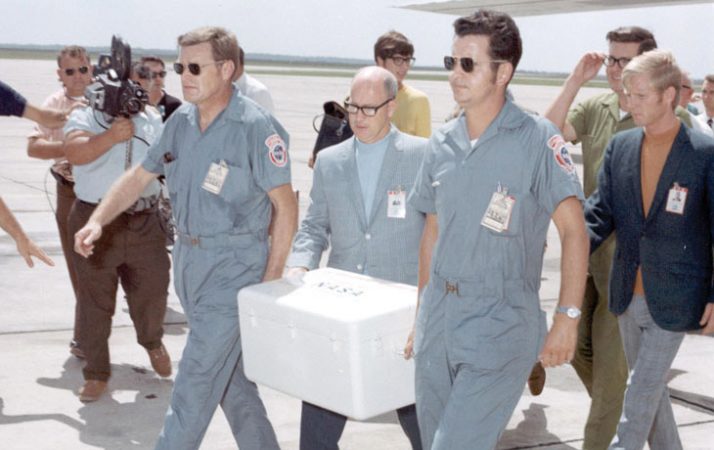
Those early samples were collected by Apollo 11 astronauts Neil Armstrong and Buzz Aldrin. They had scooped about 21.5 kilograms (47.4 pounds) of moon rocks and dirt into storage boxes.
From that first collection, about 700 grams (1.5 pounds) went to a biological test lab. There, samples were placed into secure chambers with mice, fish, birds, oysters, shrimp, cockroaches, houseflies, flatworms and single-celled organisms, plus 33 species of plants and seedlings. Scientists watched to make sure that none of the test species died or developed mutations. (They didn’t.) They also looked to see if anything grew in the moon grains themselves. (None did.)
Afterward, 7 kilograms (15 pounds) or so of the Apollo 11 rocks were parceled out to labs around the world. Researchers studying those rocks agreed not to publish what they learned from them before getting together to discuss it all at the first Lunar Science Conference. It took place here, in Houston, back in January 1970.
“No other set of geologic samples has ever been investigated so extensively,” geologist (and later Apollo 17 astronaut) Harrison Schmitt and his colleagues wrote in the introduction to the conference.
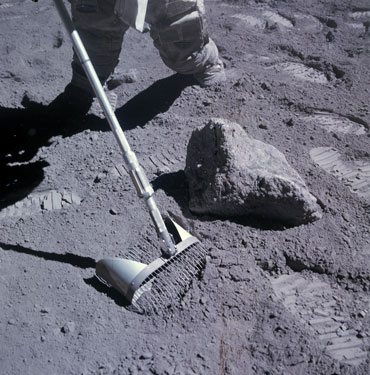
Those global studies launched the field of “lunar science.” Almost immediately, they also altered humanity’s understanding of the moon’s origin. The theory scientists came up with then is still the leading theory today. It holds that the moon formed, hot and molten, from the congealing debris of a giant impact between young Earth and some other early planet.
A hot and gooey start
The fact that scientists had the right samples to reveal that the moon was once hot and gooey was a stroke of luck.
At the end of the first moonwalk, Zeigler says, “the very last thing that happened was Neil Armstrong looked in the rock box and thought, this looks a little empty.” So Armstrong shoveled in nine scoops of soil to keep the large samples from bouncing around. “It was an afterthought.”
That extra soil contained a treasure: tiny white and light gray rocks called anorthosites (An-OR-tho-sytes).
“The anorthosites were totally unexpected,” wrote geologist John Wood and colleagues in a 1970 paper in Science. These scientists worked at the Smithsonian Astrophysical Observatory in Cambridge, Mass. The rocks’ low density suggested that they must have formed part of an ancient crust after rising to the surface of a lunar magma ocean. If a large portion of the moon was once liquid magma, heavier stuff would sink in the goo, the team reasoned. Lighter stuff, like the anorthosites, should rise. Mineralogist Joseph Smith of the University of Chicago led an independent team that came to a similar conclusion.
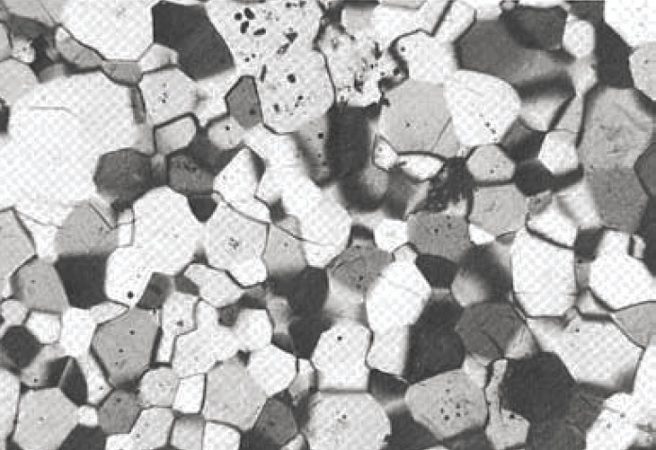
Our understanding of that lunar magma ocean is now more complex, says Steve Elardo. He’s a planetary scientist at the University of Florida in Gainesville. The moon must have gone through distinct stages to morph from that melted mass to today’s solid rock. It likely first separated into a light crust and dense mantle. Later, it would have cooled.
But when researchers date the rocks that should have come from those different eras, they all seem to be roughly the same age: 4.35 billion years old.
The result “has thrown geochemists for a loop,” Elardo says. Either their measurements were wrong, or everything happened very quickly.
“What a beaut”
Still, one main idea has held steady — that the whole moon was once liquid rock. In fact, geologists now think that’s part of the life cycle for most young planetlike bodies.
“We even talk about magma oceans, little ones, for asteroids,” Elardo says.
Those groups in 1970 had less than six months to study the samples, discover the anorthosites and figure out what it all meant. “And they basically got it right,” Elardo says.
A year later, NASA told Apollo 15 astronauts David Scott and James Irwin to look out for bright white rocks that might eventually confirm this idea. The mission transcript shows their excitement when they found such a rock during a moonwalk.
“It’s about — oh, boy!” Scott said. “Guess what we just found…. What a beaut.”
Chimed in Irwin: “I think we found what we came for.”
Krysher shows me portions of both Armstrong’s and Scott’s samples. The Apollo 11 soils fill what looks like two metal cupcake wrappers. Among a layer of dark grains, I can spot a few white flecks. Those are the anorthosites. Scott’s rock is nicknamed the Genesis Rock. Why? At the time, it was among the oldest moon rocks known.
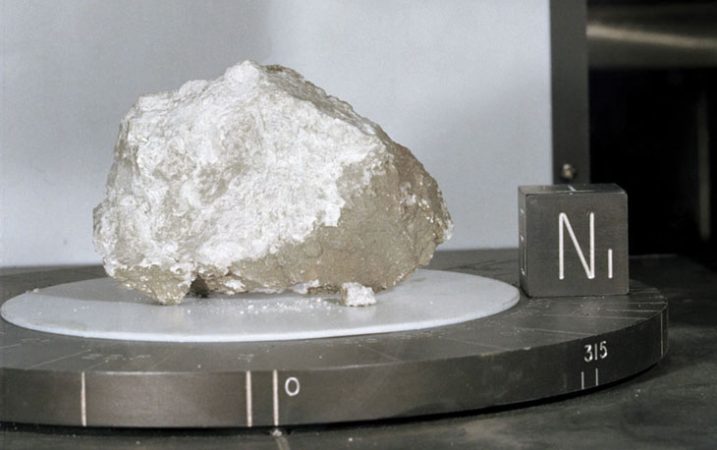
I can see why it stood out. It’s a brilliant, chalky white. The remnant on display is smaller than I expected, about the size of a lime. It could easily fit in my hand.
“May I hold it?” I ask Krysher. Nope. I had to ask, even though Zeigler had warned me in an e-mail before I arrived: “We have pretty strict rules about people putting their (gloved) hands in the cabinets to touch samples. Basically, it’s an only-if-you-walked-on-the-moon rule.”
A wet world
Keeping pristine samples away from curious fingers allowed scientists to make one of the most surprising lunar discoveries of the last half century: The moon is wet.
Over the last decade, scientists have found hundreds of times more water in lunar samples than researchers in the Apollo era realized existed.
The first studies of Apollo samples suggested that the moon was bone-dry, with less than 1 part per billion of water. That made sense: If the moon was born hot, water and other easily vaporized molecules would have boiled away quickly.
But in the late 2000s, researchers began to find hints of ancient moisture. Alberto Saal of Brown University in Providence, R.I., and his colleagues used an ion microprobe to find water molecules deep within tiny volcanic glass beads from lunar soils. His team reported its findings in 2008.
Based on the amount of water in the beads, they estimated that the magma beneath the moon’s crust could have had up to 750 parts per million water. Later studies found water in the moon’s deeper mantle, perhaps as much as in Earth’s: tens to hundreds of parts per million. Planetary scientist Francis McCubbin of NASA Johnson reported that finding this past March. He was a speaker at the Lunar and Planetary Science Conference in The Woodlands, Texas.
There’s still a lot of disagreement, McCubbin says, about exactly how much water the moon contains. But keeping lunar samples under pristine conditions had been crucial for discovering water 40 years after the rocks were brought to Earth. “Making sure we [store] those samples in a way that our grandchildren and their grandchildren can keep making discoveries is critically important,” he said.
This, I realize, is one reason why I can’t touch the moon rocks. I’m too full of water. So is the air.
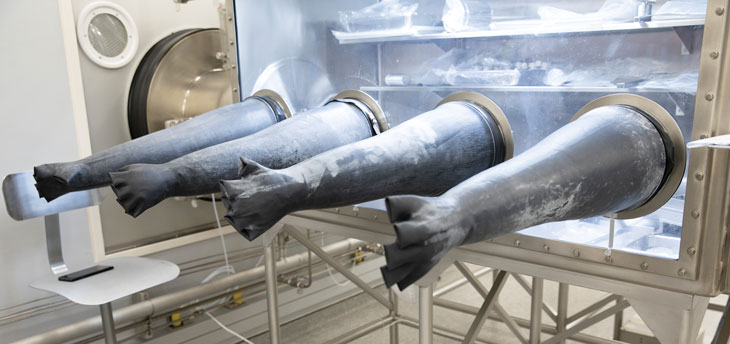
Unsung heroes
That’s the whole point of sample preservation, explains processor Lacey Costello. “Research gets all the glory.” But sample protection — or curation — is crucial.
Curation involves more than just three sets of gloves. Processors maintain a detailed database of every sample ever brought back from the moon. That includes info on every chip and slice that was ever divided from some original sample. These specialists photograph and record the mass of every subsample before moving it to a vault, behind the same kind of door that protects the U.S. gold reserves at Fort Knox. The processors even maintain the north-south and up-down orientation that the rocks had on the moon.
“We do have extensive procedures,” says processor Andrea Mosie. A Houston native, she has worked in the lunar-samples lab for 43 years. She started as a high school intern and was there in July 1969, when the first rocks arrived.
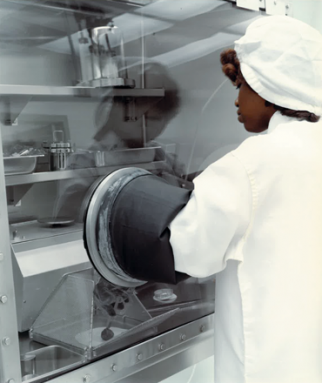
Her supervisor let her sit in on planning meetings for lunar missions. “I actually did more than I was supposed to do, which was really encouraging,” she says. “And I was in the same building with the astronauts, so that was great.”
After earning degrees in chemistry and math, Mosie returned to NASA. “The clean room has been the perfect place for me … because I’m a very picky person,” she said in a talk at the Lunar and Planetary Science Conference. “Everything has a procedure. I probably get on a lot of people’s nerves.”
Mosie trained Krysher, Costello and other curators at the lab. “She’s our moon goddess,” Krysher jokes. Krysher started in the lunar lab about five years ago, after spending the better part of a decade as an aerospace engineer.
Costello also switched from aerospace engineering to geology after a lecture on meteorites sparked a passion for planets. A newbie, she joined the lab just last January. She soon learned that a big part of her job is helping researchers identify the best sample for their studies.
“Curators acquire the most intimate knowledge of the samples,” Costello says. Often researchers “think they know what they want,” she says, but “maybe don’t.”
Once the right moon rock is chosen, processors break off a tiny piece of the main sample. A typical subsample sent to a research group weighs between half a gram and a gram, and might fill a quarter of a teaspoon.
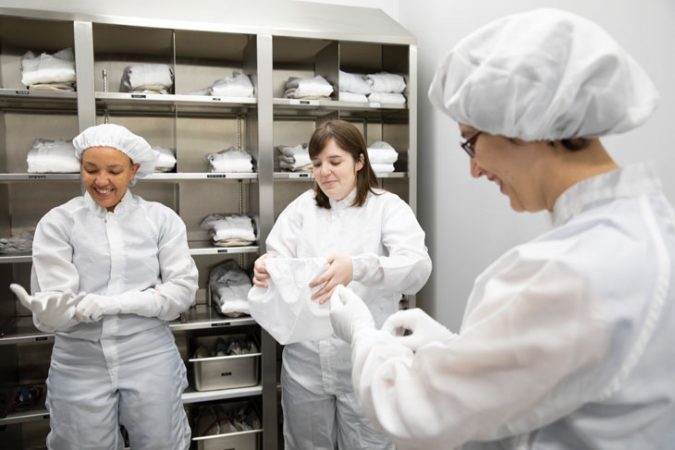
“Over the years, the scientists have been able to do more with a lot less,” Krysher says. That’s why so much of the collection is still pristine.
To minimize contamination, only three materials may come into direct contact with the samples: aluminum, stainless steel and Teflon. Hence the tweezers and extra gloves. And if dust or a piece of a rock breaks off during sampling, that bit becomes a new sample.
I finally get my chance to play processor. I see an empty cabinet, and to my delight, my guides let me put my double-gloved hands in and pretend to process a sample.
Rare opportunities
I struggle to stretch my fingers into the gloves, which wave like balloons from the higher pressure inside the cabinet. The rubber wraps tightly around my arms: I almost feel like I’m pushing my arms into a thick liquid. Inside the cabinet, I clumsily pick up a stainless steel hammer and a chisel. I mimic chipping a corner off of an imaginary sample. Even without a real moon rock, I find myself laughing with joy.
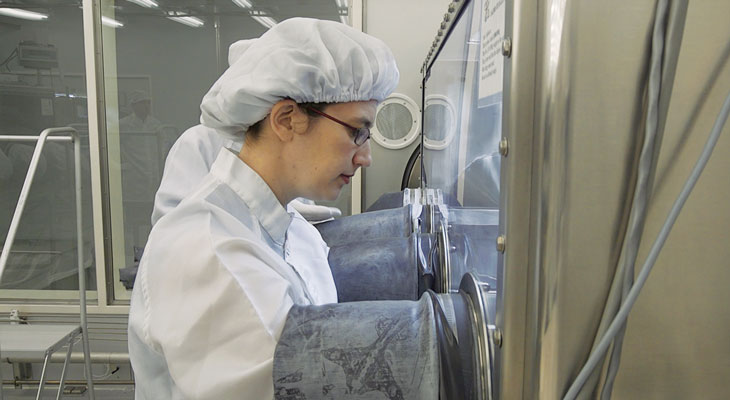
For the curators, “that excitement lasts forever,” Mosie tells me. “Every time you handle a sample, you … realize that you’re one of the few who will ever be doing this.… That’s a special opportunity, and it’s an awesome responsibility.”
Geologist Beck Strauss remembers that feeling. While a postdoc at Rutgers University in Piscataway, N.J., Strauss got to open a pristine sample from Apollo 12.
“That was one of the coolest things I’ve gotten to do — to be the first person to hold a piece of this rock,” says Strauss, now at the National Institute of Standards and Technology in Gaithersburg, Md.
At Rutgers, Strauss and their colleagues studied magnetic fields preserved in lunar rocks to figure out how the moon’s interior has changed over time. Churning liquid rock in the moon’s core, or at the boundary between the core and mantle, could have driven a magnetic field that weakened as the moon cooled and turned solid.
Strauss presented work at the March Lunar and Planetary Science Conference suggesting that the early moon had a strong magnetic field — one that faded by 3 billion years ago. The moon maintained a weaker magnetic field for another 1 billion to 2 billion years before the field dropped to essentially nothing.
This research “let us get at information that was just physically inaccessible during the Apollo era.”
And Strauss feels a part of that history. “For me to do the experiments I’m doing and collect the data I have, we basically had to invent spaceflight,” Strauss says. Nearly 50 years after Apollo, Strauss got to walk into the lab, open a safe, “and take out these incredible little pieces of our moon and learn all sorts of really cool things about them. I think that’s awesome.”
When NASA sends samples to research labs, no special government courier service is used. Packages travel by regular mail, FedEx or UPS. To deter thieves, the curators make the packages look boring. “We obviously don’t write: ‘This is a moon rock in here,’ ” Mosie says. She admits that a few samples have been lost in the mail. But there’s no point insuring them. “They’re priceless,” she says. No amount of money can replace them.
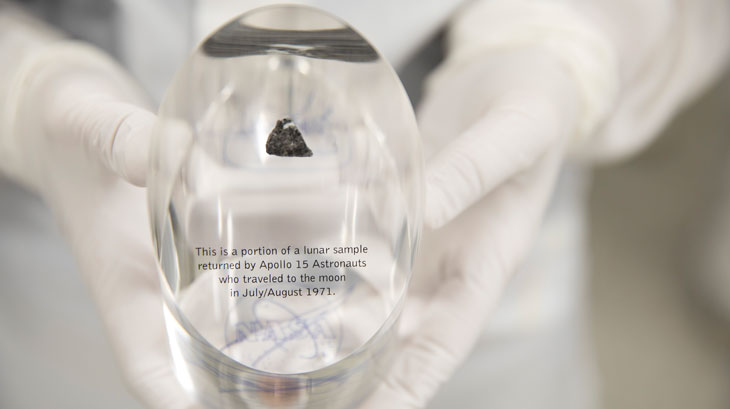
Hidden treasures
The good news: Ways exist to find new samples in the same old rocks. A lot of the Apollo rocks are cement-like aggregates. Called breccias (BREH-chee-uhs), they can hide rocks inside that aren’t visible from the outside. Until recently, the only way to find those hidden rocks was to break breccias open with a chisel. But in 2017, the pristine-sample lab got a CT scanner. It now allows scientists there to take a look inside the rocks without breaking them. That will let curators know where to cut the rocks to extract unseen bits.
Some untouched samples are about to come out of storage. Three tubes of soil pulled from the lunar surface during Apollo 15, 16 and 17 have been sealed since the 1970s. In March, NASA announced that nine research teams will receive precious bits from those tubes.
And new missions are on the horizon. In April, NASA Administrator Jim Bridenstine announced a proposal to land U.S. astronauts on the moon again as early as 2024. China plans to launch a sample-return mission to the farside of the moon later this year. Those moon rocks will be the first samples from that region of the moon and the first returned at all since 1976.
Says Zeigler at the Houston lab, “Getting samples from another part of the moon would revolutionize our understanding of the moon and of the solar system, just like the Apollo samples did.”
I thought I might have to apply to be an astronaut to finally get my hands on a moon rock. But I found an easier way. The Smithsonian National Air and Space Museum in Washington, D.C., has a slice of basalt. Called the Touch Rock, it was retrieved by Apollo 17. Owing to museum renovations, it currently is not on display. But it should be back again by mid-November. Then anyone can walk right up and touch it.
I couldn’t suppress a smile when I ran my fingers over it. The stone is cool and smooth, like a river rock. But instead of being worn down by water and time, this piece of our moon has been polished by millions of human hands.
